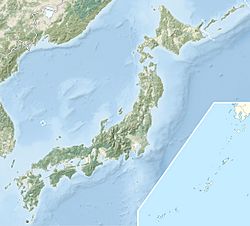1707 Hōei earthquake facts for kids
| Local date | 28 October 1707 |
|---|---|
| Local time | 14:00 |
| Magnitude | 8.6 ML, Mw 8.7 |
| Epicenter | 33°00′N 136°00′E / 33.0°N 136.0°E |
| Fault | Nankai megathrust |
| Areas affected | Japan: Chūbu region, Kansai region, Shikoku, Kyūshū |
| Tsunami | yes |
| Casualties | >5,000 |
The 1707 Hōei earthquake was a massive earthquake that struck Japan on October 28, 1707, at 2:00 PM local time. It was one of the strongest earthquakes ever recorded in Japanese history. This powerful quake caused a lot of damage and even triggered a huge tsunami.
Contents
Understanding the Earthquake's Cause
The southern coast of Honshū in Japan sits right above a special area called the Nankai Trough. This trough is where two of Earth's giant plates meet. The Philippine Sea Plate is slowly sliding underneath the Eurasian Plate. This constant movement causes a lot of stress to build up.
When this stress becomes too much, the plates suddenly slip. This sudden movement creates very powerful earthquakes, known as megathrust earthquakes. The Nankai Trough has several sections that can break. Sometimes, these sections break one by one. Other times, they all break at once. Over the last 1,300 years, many large earthquakes have happened here. The 1707 Hōei earthquake was one of these giant events.
Damage from the Hōei Earthquake
The 1707 Hōei earthquake caused widespread destruction across Japan.
- More than 29,000 houses were completely destroyed.
- Sadly, over 5,000 people lost their lives.
The earthquake also triggered a huge landslide in Shizuoka Prefecture. This landslide was one of the biggest ever seen in Japan. It covered an area of about 1.8 square kilometers. That's like covering 180 football fields!
In the Nara Basin, the ground itself became like a liquid. This process is called soil liquefaction. It happens when strong shaking makes loose, wet soil lose its strength. Buildings can then sink or tilt over.
Earthquake Strength and Tsunami Impact
How Strong Was the Earthquake?
The 1707 Hōei earthquake was incredibly powerful. It was even stronger than two other very large earthquakes that hit Japan in 1854. These were the 1854 Ansei-Tōkai earthquake and the 1854 Ansei-Nankai earthquake.
Scientists know the 1707 quake was bigger from several clues:
- At Cape Muroto in Kōchi Prefecture, the land was pushed up by about 2.3 meters in 1707. In 1854, it only rose 1.5 meters.
- In the Kawachi Plain area, the shaking felt like a 6 or 7 on the JMA scale. This scale measures how much the ground shakes.
- The amount of damage and the height of the tsunami waves also showed how strong the earthquake was.
The earthquake was so big that its effects were felt far away. Records show that tsunamis reached distant places like Nagasaki in Japan and Jeju-do in South Korea.
The Giant Tsunami Waves
A massive tsunami followed the earthquake. These giant waves crashed onto the coast, causing even more damage. Along the southwestern coast of Kōchi, the sea level rose by an average of 7.7 meters (about 25 feet). In some areas, the waves reached an incredible height of 10.2 meters (about 33 feet)! Imagine a three-story building made of water crashing onto the shore.
Mount Fuji and the Earthquake
Did you know that very large earthquakes can sometimes affect volcanoes? When a huge earthquake happens, it can change the pressure deep inside the Earth. If a volcano's magma system is already close to erupting, a big earthquake might be enough to trigger it.
Scientists believe that the 1707 Hōei earthquake might have changed the pressure in the magma under Mount Fuji. About 49 days after the earthquake, Mount Fuji had a major eruption. This eruption is known as the Hōei eruption of Mount Fuji. It's a fascinating example of how different natural events can be connected.
Related pages
See also
 In Spanish: Terremoto de Hōei de 1707 para niños
In Spanish: Terremoto de Hōei de 1707 para niños



